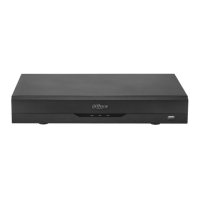
Do you have a question about the Dahua DH-XVR5104H-4KL-X and is the answer not in the manual?
| Video Output | 1 x HDMI, 1 x VGA |
|---|---|
| Compression | H.265+/H.265/H.264+/H.264 |
| USB Interface | 2 x USB 2.0 |
| Video Input | 4 channels |
| Max Resolution | 3840 x 2160 |
| Storage Capacity | Up to 10TB HDD |
| Network Interface | 1 x RJ45 |
| Power Supply | 12V DC |
| Operating Temperature | -10°C to +55°C (+14°F to +131°F) |
| Max IP Camera Input | 4 channels |
| Audio In/Out | 1 channel in/1 channel out |
| Hard Drive Support | 1 SATA |
| Smart Functions | Motion Detection |
| Alarm Input | 4 channels |
| Operating Humidity | 10% to 90% |
| Weight | 1.5kg |
Lists essential steps for improving system security, including password changes and firmware updates.
Explains categorized signal words used for hazard indication and their meanings.
Details crucial safety measures related to electrical connections, power adapters, and batteries.
Provides step-by-step instructions for installing an HDD, including precautions.
Illustrates the standard wiring and connection setup for cameras and peripherals.
Details the setup for alarm input ports, alarm output ports, and PTZ decoder connections.
Guides through the first-time setup process including password and system initialization.
Explains methods for resetting forgotten admin passwords via local or web interfaces.
Covers viewing live video, control bar functions, navigation, and shortcut menus.
Details how to connect and operate PTZ cameras, including presets, tours, and patterns.
Covers image adjustment, encoding, overlays, channel types, and coaxial camera upgrades.
Explains how to add, initialize, modify, and manage remote IP cameras.
Covers enabling record control and configuring recording parameters like schedule and event types.
Guides on playback controls, search types, clipping recorded video, and backing up files.
Covers alarm information, input, output, video detection, system events, and smart detection settings.
Details network settings including TCP/IP, Wi-Fi, 3G/4G, PPPoE, DDNS, Email, UPnP, SNMP, and 802.1x.
Covers user accounts, groups, ONVIF users, and security questions for admin access.
Covers basic settings, HDD management, quotas, record estimation, and FTP storage.
Explains how to access the device through its web interface using username and password.
Details the process for resetting the password via the web interface using QR code or security questions.











